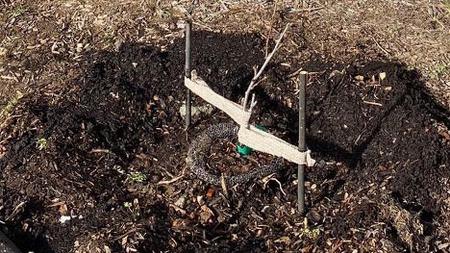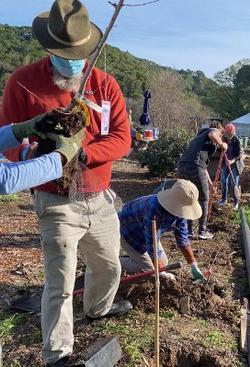News from the Edible Demo Garden
February 2022: Getting Bare Root Fruit Trees Off to a Good Start

• Braeburn apple
• Pink Pearl apple
• Ambrosia pomegranate
• O'Henry peach
• Shinseki Asian pear
• Blackjack fig
Bare root fruit trees are readily available during winter and early spring and there are advantages to planting them at this time of year. Not only are they less expensive, but they can also establish more quickly in the natural garden soil because they have not been previously grown in containers.
Bare root planting tips

If you are not able to plant right away, “heel in” the plants by placing them in a hole or shallow trench and covering the roots with moist soil or sawdust. Soak the roots in water for 1 to 2 hours prior to planting. Trim off any dead, twisted or broken roots
Dig the right-sized hole
Dig the planting hole large enough to easily accommodate all the healthy roots. Don’t make the hole any deeper than the roots of the tree but allow enough width for the roots to spread out. If gophers are a problem, as they are in the Edible demonstration garden, encase the roots in a wire basket large enough to allow the roots to grow for several years. Make sure the top extends above the soil level.
Plant at the right depth
Make a small cone of soil in the center of the hole and place the tree so that the roots fan out around the cone. The root crown should be at the soil level. Allow for some settling after planting. Orient the tree so that the graft union faces north or northeast to reduce heat stress and sunburn.
Fill the hole
Hold the tree in place while backfilling with clod free soil removed from the site. Don’t add amendments or fertilizers. Firm the soil around the sides of the root system to remove air pockets but don’t pack too tightly. Add compost or mulch to the soil surface keeping it away from the base of the tree. Make a slightly raised ridge of soil around the outer edge of the planting hole to create a basin.
Water thoroughly
Water slowly and gently until the soil is completely moistened and the tree is settled in place. After the initial watering, water only as needed when rainfall is insufficient. New trees need enough water to encourage root growth, but overwatering can kill them. Drip irrigation can be installed after planting.
Prune the tree
Cut back the branches to about knee height. This promotes lower branching and a smaller and stronger tree. Controlling the tree height makes later fruit harvesting much easier. More on pruning.
Add stakes if needed
Stakes can protect and support the trunk during the first year or so. Stakes should be placed so the trunks can flex some with the wind in order to develop strength. See staking trees for more information.
For more information see: How to plant a bare root tree
